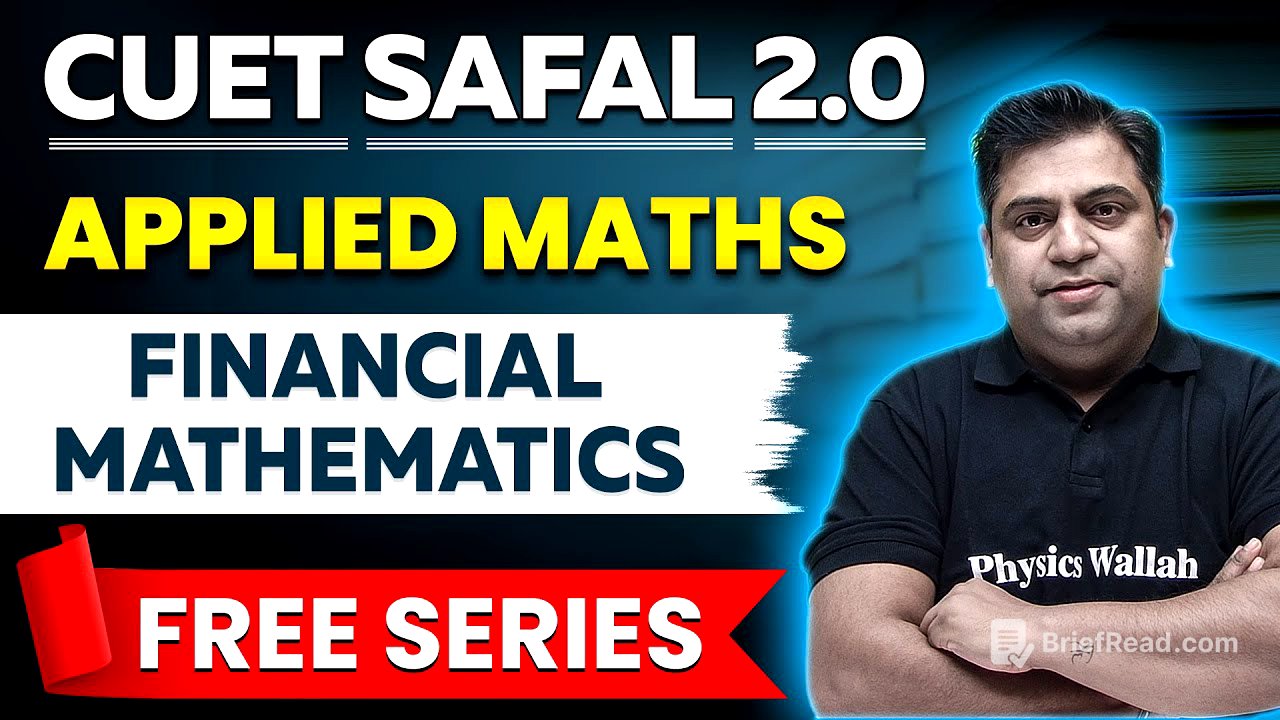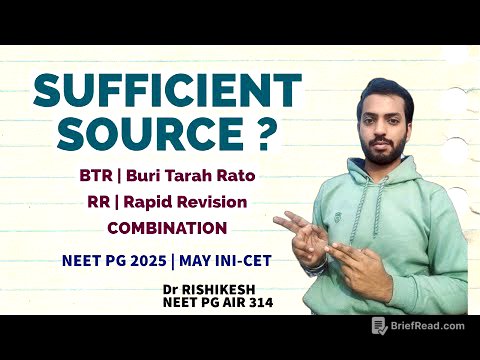TLDR;
नमस्ते! This video is a comprehensive guide to the Financial Mathematics chapter for the CUET exam. It covers key topics like Perpetuity, Sinking Fund, EMI, Depreciation, and Bonds. The instructor emphasises understanding the concepts, remembering formulas, and practicing calculations.
- Key topics covered: Perpetuity, Sinking Fund, EMI, Depreciation, and Bonds.
- Focus on formula memorization and calculation practice.
- Tips and tricks for solving CUET-level questions efficiently.
Introduction to Financial Mathematics [0:01]
The video introduces the Financial Mathematics chapter, highlighting its importance for the CUET exam. The chapter covers five key topics: Perpetuity, Sinking Fund, EMI (Equated Monthly Installment), Depreciation, and Bonds. The instructor stresses the importance of remembering formulas and practicing calculations to solve problems efficiently. He also mentions that while the formulas might seem complex, the CUET questions are designed to be solvable with reasonable calculations.
Perpetuity: Understanding Infinite Annuities [2:10]
Before diving into perpetuity, the instructor revises the concept of annuity from Class 11. Annuity involves fixed payments at fixed intervals. Perpetuity is a type of annuity where the payments continue forever, meaning the time period is not defined. Examples include rent from a property that you plan to rent out indefinitely or dividends from a stock you plan to hold forever. Since the time period is infinite, perpetuity only has a present value, not a future value. There are two types of perpetuity: Type 1, where payments are made at the end of the interval, and Type 2, where payments are made at the beginning of the interval.
Types of Perpetuity and Formulae [11:41]
The instructor explains the two types of perpetuity: Type 1 (payments at the end of the interval) and Type 2 (payments at the beginning). He provides the formulas for calculating the present value (PV) of each type:
- Type 1: PV = R / i
- Type 2: PV = R + (R / i)
Where R is the regular payment and i is the compound rate of interest. The formula for calculating the compound rate of interest (i) is also given: i = (R / M) * 100, where R is the rate of interest and M is the compounding factor (e.g., 2 for semi-annual, 4 for quarterly, 12 for monthly).
Perpetuity: Example Problems and Solutions [17:37]
The instructor solves several example problems to illustrate the application of the perpetuity formulas. He demonstrates how to calculate the present value of a perpetuity given the regular payment, rate of interest, and compounding frequency. He also shows how to find the rate of interest when the present value and regular payment are known. The instructor emphasises simplifying calculations and using options to arrive at the answer quickly.
Sinking Fund: Accumulating Funds for Future Obligations [33:27]
The video transitions to the topic of Sinking Funds. A sinking fund is a fund created to accumulate money over time to meet a future obligation, such as upgrading machinery or replacing a car. Unlike a savings account, a sinking fund involves regular payments over a defined period. The formula for calculating the amount accumulated (A) in a sinking fund is: A = R * [(1 + i)^n - 1] / i, where R is the regular payment, i is the compound rate of interest, and n is the time period (number of payments).
Sinking Fund: Formula and Example Problems [37:56]
The instructor explains the components of the sinking fund formula: A (amount to be accumulated), R (regular payment), n (time period), and i (compound rate of interest). He solves example problems to demonstrate how to calculate the regular payment required to reach a specific amount in a sinking fund, given the interest rate and time period. He also provides tips for simplifying calculations and using options to arrive at the answer quickly.
EMI: Understanding Equated Monthly Installments [52:07]
The video moves on to the topic of EMI (Equated Monthly Installment). The instructor clarifies that EMI stands for Equated Monthly Installment, not Easy Monthly Installment. EMI is a fixed amount paid on a fixed date every month to repay a loan. The video explains two methods for calculating EMI: Flat Rate Method and Floating Rate Method.
EMI: Flat Rate Method [54:24]
The instructor explains the Flat Rate Method for calculating EMI. In this method, the interest rate remains fixed throughout the loan tenure. The formula for calculating EMI using the flat rate method is: EMI = (P + P * N * I) / N, where P is the principal borrowed, N is the number of months, and I is the interest rate per rupee per month.
EMI: Floating Rate Method [58:17]
The instructor explains the Floating Rate Method for calculating EMI. In this method, the interest rate fluctuates based on market conditions. The formula for calculating EMI using the floating rate method is: EMI = P * i * (1 + i)^n / [(1 + i)^n - 1], where P is the principal borrowed, i is the interest rate per month, and n is the number of months. He also presents an alternative form of the formula that is useful when the value of (1 + i)^n is directly provided in the question.
Amortization of Loan: Breaking Down EMI Components [1:02:04]
The video discusses the amortization of a loan, which involves breaking down each EMI payment into its principal and interest components. The instructor explains that in the initial stages of a loan, a larger portion of the EMI goes towards paying interest, while a smaller portion goes towards reducing the principal. Over time, this reverses, with a larger portion going towards principal and a smaller portion towards interest.
EMI: Formulae for Principal and Interest Calculation [1:06:46]
The instructor provides the formulas for calculating:
- Principal outstanding at the beginning of the Kth month.
- Interest paid in the Kth month.
- Principal paid in the Kth month.
- Total interest paid over the loan tenure.
These formulas are essential for understanding the amortization schedule of a loan.
EMI: Example Problems and Homework [1:12:06]
The instructor solves an example problem to demonstrate the application of the flat rate method for calculating EMI. He then assigns several homework problems involving the floating rate method and amortization calculations, encouraging viewers to solve them and share their answers in the comments.
Depreciation: Understanding Asset Value Reduction [1:35:32]
The video transitions to the topic of Depreciation. Depreciation is the reduction in the original value or cost of a fixed asset due to wear and tear or obsolescence. The instructor explains the concept of scrap value, which is the value at which a fixed asset is disposed of after its useful life.
Depreciation: Straight Line Method [1:41:57]
The instructor explains the Straight Line Method of depreciation. In this method, the asset depreciates uniformly over its useful life. The formula for calculating annual depreciation is: (Original Cost - Scrap Value) / Number of Useful Years.
Depreciation: Declining Balance Method [1:46:39]
The instructor explains the Declining Balance Method (also known as Written Down Value Method) of depreciation. In this method, the asset depreciates at a fixed percentage each year. The formula for calculating scrap value is: Original Cost * (1 - i)^n, where i is the rate of depreciation and n is the number of years.
Depreciation: Sum of Years' Digits Method [1:51:14]
The instructor explains the Sum of Years' Digits Method of depreciation. In this method, the depreciation expense is higher in the early years of the asset's life and lower in the later years. The depreciation is calculated based on a fraction, where the numerator is the remaining useful life of the asset and the denominator is the sum of the years' digits.
Depreciation: Example Problems [1:54:26]
The instructor solves several example problems to illustrate the application of the depreciation methods. He demonstrates how to calculate the original cost, scrap value, and annual depreciation using the straight-line method. He also solves a challenging problem involving the declining balance method, requiring careful algebraic manipulation.
Bonds: Understanding Debt Securities [2:18:42]
The video transitions to the topic of Bonds. A bond is a long-term debt security issued by a company or government to raise capital. It's essentially a loan taken from investors, with a promise to repay the principal amount (face value) along with periodic interest payments (coupon payments).
Bonds: Terminology - Face Value and Coupon Rate [2:22:22]
The instructor explains key bond terminology:
- Face Value: The principal amount of the bond, which is repaid at maturity.
- Coupon Rate: The rate of interest paid on the face value of the bond.
Bonds: Terminology - Maturity Date, Coupon Payment, Yield to Maturity [2:24:08]
The instructor continues explaining key bond terminology:
- Maturity Date: The date on which the face value of the bond is repaid.
- Coupon Payment: The periodic interest payment received from the bond.
- Yield to Maturity (YTM): The total return anticipated on a bond if it is held until it matures.
Bonds: Present Value Formula [2:26:35]
The instructor presents the formula for calculating the present value (PV) or fair value of a bond:
PV = C * [1 - (1 + i)^-n] / i + F * (1 + i)^-n
Where:
- C = Coupon Payment
- i = Compound Discount Rate (YTM)
- n = Time Period
- F = Face Value of Bond
He also explains how to calculate the coupon payment (C) when it is not directly given, using the formula: C = F * R / 100, where R is the coupon rate.
Bonds: Example Problem 1 [2:29:41]
The instructor solves an example problem to demonstrate the application of the bond valuation formula. He calculates the fair value of a bond given its face value, coupon rate, yield to maturity, and time period.
Bonds: Example Problem 2 [2:34:28]
The instructor solves another example problem, this time calculating the approximate annual coupon rate of a bond given its face value, present value, yield to maturity, and time period.
Bonds: Approximate Yield to Maturity Formula [2:50:54]
The instructor introduces a direct formula to calculate the approximate Yield to Maturity (YTM) or Discounted Rate, avoiding the need for logarithms:
YTM = (C + (F - PV) / N) / ((F + PV) / 2)
Where:
- C = Coupon Payment
- F = Face Value
- PV = Present Value
- N = Time Period
He emphasizes that this formula provides an approximate value and is useful for quick calculations.
CUET 2023: Bond Question [2:55:14]
The instructor solves a bond question from the CUET 2023 exam, demonstrating the application of the bond valuation formula in a real exam scenario.
CUET 2023: Depreciation Question [3:01:55]
The instructor solves a depreciation question from the CUET 2023 exam, demonstrating the application of the straight-line depreciation method.
CUET 2023: EMI Question and Conclusion [3:03:23]
The instructor solves an EMI question from the CUET 2023 exam, demonstrating the application of the flat rate method for calculating EMI. He concludes the video by summarising the key topics covered in the Financial Mathematics chapter and providing tips for exam preparation, including practicing calculations, prioritizing questions, and managing time effectively. He wishes the viewers all the best for their exams.









